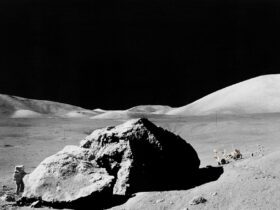“Like finding a snowball that hasn’t melted in a fire.”
Deep in space, where planets are either roasting or frozen, astronomers just found an impossible world—a Neptune-sized exoplanet that orbits its star so closely it should have evaporated long ago. Meet LTT 9779 b, a searing-hot world that defies everything we thought we knew about planetary survival.
Using the James Webb Space Telescope (JWST), scientists have now peered into its bizarre atmosphere—and the results are jaw-dropping.
A Planet That Shouldn’t Exist—But Does
LTT 9779 b sits in the “Neptunian desert”—a hellish zone where planets like it aren’t supposed to survive. The reason? Extreme heat from the nearby star should strip away its atmosphere, leaving behind a barren rock.
And yet, LTT 9779 b is still standing.
This ultra-hot Neptune is 29 times Earth’s mass and 4.7 times its radius. But here’s the kicker:
- A “year” on LTT 9779 b lasts just 17 hours—it’s that close to its star.
- Its surface reaches 3,632°F (2,000°C)—hotter than molten lava.
- It’s “tidally locked”—meaning one side is always blazing hot, while the other is stuck in perpetual darkness.
So why hasn’t it burned up?
Webb’s Deep Dive: A Sky Made of Rock Clouds
NASA’s James Webb Space Telescope just did a 22-hour deep scan of LTT 9779 b—and what it found is nothing short of astonishing.

- Unlike Earth’s water-vapor clouds, LTT 9779 b’s clouds are rich in silicates (the stuff that forms sand and rock).
- These mineral clouds exist only on the slightly cooler western hemisphere, while the hotter eastern side is completely cloudless.

- The reason for this half-cloudy, half-barren atmosphere? Winds moving at thousands of miles per hour, redistributing heat.
- These winds carry clouds from the cooler side to the hotter side, where they instantly evaporate—a weather pattern scientists have never seen before.

One theory: LTT 9779 b’s atmosphere might reflect enough stellar radiation to slow down the usual process of planetary evaporation. But the full answer? Still a mystery.
Why This Discovery Matters
The survival of LTT 9779 b flips the script on planetary science. It challenges:
- How planets form near stars without getting obliterated.
- How atmospheres persist in extreme heat.
- What “Neptunian desert” planets actually look like.
More importantly, it opens the door to discovering even more bizarre, unexpected worlds. If LTT 9779 b can survive in the worst conditions possible, what else is out there?
FAQs
Q: Why is LTT 9779 b important?
Because it shouldn’t exist! It’s the first time scientists have seen a Neptune-like planet this close to a star with its atmosphere still intact.
Q: What did Webb discover about its atmosphere?
It found silicate clouds (made of minerals, not water) and insanely strong winds that move heat around the planet.
Q: Could life exist on LTT 9779 b?
Absolutely not. The temperature is hotter than molten iron, and the planet is bathed in extreme radiation. This is an exoplanet built for destruction, not life.
Q: What’s next for this research?
Astronomers are using data from Hubble, the Very Large Telescope, and future Webb observations to uncover even more about its dayside cloud structures and atmospheric loss rates.
The Universe Keeps Surprising Us
LTT 9779 b is a planetary paradox—a world that should have been vaporized, yet here it is, standing defiant. Webb’s eye into this inferno is just the beginning of a whole new chapter in exoplanet science.
Who knows? Maybe the next “impossible planet” is already out there, waiting to be found.












Leave a Reply